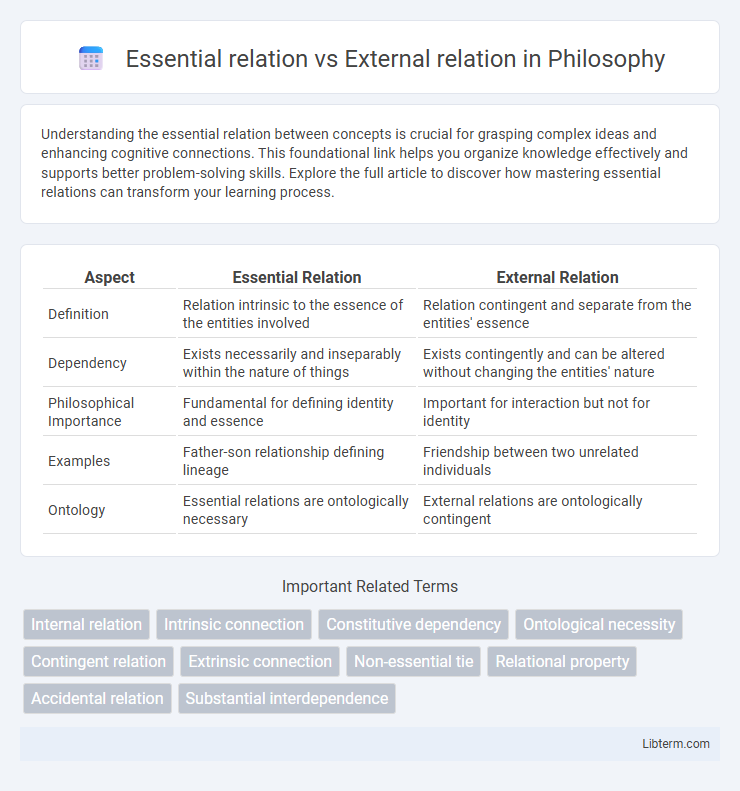Understanding the essential relation between concepts is crucial for grasping complex ideas and enhancing cognitive connections. This foundational link helps you organize knowledge effectively and supports better problem-solving skills. Explore the full article to discover how mastering essential relations can transform your learning process.
Table of Comparison
| Aspect | Essential Relation | External Relation |
|---|---|---|
| Definition | Relation intrinsic to the essence of the entities involved | Relation contingent and separate from the entities' essence |
| Dependency | Exists necessarily and inseparably within the nature of things | Exists contingently and can be altered without changing the entities' nature |
| Philosophical Importance | Fundamental for defining identity and essence | Important for interaction but not for identity |
| Examples | Father-son relationship defining lineage | Friendship between two unrelated individuals |
| Ontology | Essential relations are ontologically necessary | External relations are ontologically contingent |
Understanding Essential and External Relations
Essential relations define the inherent and unchanging connections between entities, forming the core structure of a concept or system. External relations describe the interactions or dependencies between entities and external factors, emphasizing contextual influences and environmental dynamics. Understanding these distinctions clarifies how objects or ideas maintain identity internally while adapting to external conditions.
Defining Essential Relations
Essential relations define the core connections inherent to the identity or nature of entities, determining their fundamental characteristics and roles within a system. These relations are intrinsic and necessary, forming the foundation for understanding the structure and behavior of objects or concepts in ontology and knowledge representation. Distinguishing essential relations from external relations, which are contingent and context-dependent, allows for clearer semantic modeling and more accurate data interpretation.
Defining External Relations
External relations involve connections between distinct entities or systems, highlighting interactions that occur outside an entity's internal framework. Defining external relations requires specifying the nature, context, and rules governing these interactions to ensure clear boundaries and interoperability. Essential relations, by contrast, underpin an entity's core properties or internal structure, whereas external relations emphasize the linkage and communication between separate entities.
Historical Background of Relation Concepts
Essential relation and external relation concepts trace back to Aristotelian philosophy, where essential relations are intrinsic properties defining the essence of entities, while external relations are contingent and based on interactions. Medieval scholastic thinkers further refined this distinction by emphasizing how essential relations shape the identity of substances, contrasting with external relations that connect entities without altering their core nature. Modern metaphysics continues to explore these foundational ideas, highlighting their significance in ontology and the philosophy of relations.
Key Differences Between Essential and External Relations
Essential relations define the necessary, inherent connections between entities that exist by virtue of their nature, such as the relationship between a person and their identity. External relations occur between entities based on external circumstances or contexts, without depending on their intrinsic properties, like the relationship between two people sharing a room. The key difference lies in essential relations being dependent on the intrinsic characteristics of the entities, whereas external relations are contingent on extrinsic factors and situational context.
Philosophical Perspectives on Relations
Essential relations refer to connections that are inherent and necessary to the identity or nature of entities, according to metaphysical realism. External relations, by contrast, are contingent and do not affect the fundamental essence of the related entities, often highlighted in nominalist viewpoints. Philosophers such as Leibniz argue that essential relations ground the unity of substances, while thinkers like Russell emphasize that external relations structure the world without altering the nature of individual objects.
Essential Relations in Science and Logic
Essential relations in science and logic represent inherent connections that define the identity or nature of entities, such as the relationship between a triangle and its three sides. These relations are necessary and unchanging, as opposed to external relations which depend on contingent or situational factors. Understanding essential relations is crucial for defining properties, establishing axioms, and formulating theories that reflect the true nature of scientific and logical constructs.
External Relations in Social and Ethical Contexts
External relations in social and ethical contexts emphasize interactions and dependencies between distinct entities or groups, shaping norms and responsibilities beyond inherent characteristics. These relationships influence societal structures, ethical obligations, and mutual recognition, highlighting how external factors define roles and duties. Understanding external relations is crucial for addressing social justice, cooperation, and conflict resolution within diverse communities.
Practical Implications of Relation Types
Essential relations define inherent connections within a concept, ensuring stability and consistency in knowledge representation, which is crucial for accurate reasoning and inference in AI systems. External relations describe context-dependent associations that vary based on circumstances, enabling flexible modeling of real-world scenarios and dynamic interactions. Understanding the distinction helps optimize semantic networks and ontologies for practical applications like natural language processing, data integration, and decision-making algorithms.
Comparing Essential and External Relations: Summary
Essential relations define inherent, necessary connections within an entity or system, grounding its identity and function, while external relations concern interactions between distinct entities or systems, influencing their dynamics and mutual dependencies. Essential relations are intrinsic and stable, often determining the core nature or structure, whereas external relations are contextual and variable, shaped by environmental or situational factors. Comparing these highlights that essential relations provide foundational stability, whereas external relations drive adaptability and external engagement.
Essential relation Infographic

 libterm.com
libterm.com